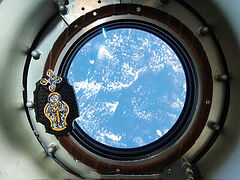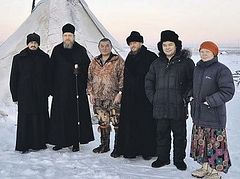Nature—stones, water, trees, grass, insects, birds, mammals, fish... How beautiful they are, and it is absolutely obvious that this beauty is filled with the Spirit; it couldn’t have been formed by “evolution”—a faceless, impersonal force. The Creator, the Artist is present in this beauty. Can we admire nature without our hearts praising its Creator?
Priest Dionisy Vescu serves in the Diocese of Pokrovsk and Novouzensk, which is part of the Saratov Metropolia in the area of the Trans-Volga steppes in southwestern central Russia. He is the rector of the Church of the holy Martyr John the Soldier in the village of Lavrovka of the Krasny Kut district of the Saratov region. He rarely parts with his camera, sharing the beauty of the world around him with everyone. Not long ago an exhibition of his photographs was held at the educational center of the Pokrovsk Diocese, and earlier they were exhibited in the town of Krasny Kut. It may sound banal, but indeed these photographs do not leave anyone indifferent.
 Priest Dionisy Vescu Let us first ask Father Dionisy to tell us about himself and the path that led him to the priesthood:
Priest Dionisy Vescu Let us first ask Father Dionisy to tell us about himself and the path that led him to the priesthood:
“I was born in Moldova. I graduated from the Moldova State University in Chisinau (the Department of Biology). My specialty was ichthyology and hydrobiology. I received a Master’s degree and was engaged in science. I was a parishioner of St. George’s Russian Orthodox Church. And at some point I realized that it was high time to answer the question: ‘What can I do for the Church, for God?’ I would gladly clean the church floor or guard it at night... But when I approached with this question our church rector, Archpriest Nikolai Florinsky, he said, ‘Go to Saratov and enter the seminary there.’ I was very surprised, wondering why he was sending me to Saratov—after all, there were many Orthodox seminaries much closer to me. But, apparently, such was God’s Providence in my life. And I had to decide whether or not to trust in this Providence.”
The future Fr. Dionisy chose to trust God. As a highly qualified ichthyologist, he had worked at the Academy of Sciences of Moldova. The prospects of scientific work were opening up before him. But he abandoned everything, resigning from the Academy, the university and the vocational school where he had taught biology, collecting his documents and moving to Saratov—a faraway city on the Volga River. He met Bishop Longin (now Metropolitan of Simbirsk and Novospasskoye), enrolled in the seminary… and met his future wife Maria, a biologist, there. Now their son Benjamin shares his father's love for the nature of the steppes, which have become so close to Fr. Dionisy’s heart, although he is a native of Moldova, where the landscape is quite different.
“I am passionate about nature,” Father Dionisy proceeds. “I want to photograph this beauty while it is still here. I try to notice it everywhere and draw the attention of other people to it. I show photos to my parishioners in Lavrovka, all of whom live in this steppe region. All the pictures were taken around the village, but locals always wonder, ‘Is this all photographed here? Do all these birds really live here?...’ And, of course, they can’t identify these birds and don’t know their names. We need to help these people tear their eyes away from the TV, from the telephone, from everyday chores, and help them see the beauty that still surrounds them—because it is wrong not to notice this Divine beauty. Thus, wherever I go, I always take a camera with me.”
Fr. Dionisy shares his experience: if you see an interesting bird on a steppe road, on a tree or electrical wires, do not stop the car suddenly and do not get out: this will frighten the bird. Brake gradually, switch to the first gear and take pictures through the window to prevent the “model” from noticing your interest in it. He has many such secrets...
“A hare ran across the road in front of me. I froze and it froze as well. It was a good ‘photo session’. And yesterday in the Atkarsk district my son and I photographed marmots. There is a stunningly beautiful place there—abandoned sand quarries near the village of Doktorovka: outcrops of rocks, polished by water and sand, are just fantastic, especially at sunset...”
As Fr. Dionisy was showing me his pictures, I started wondering why we travel to the other end of the world to spend our vacations if we have such beautiful places within a two-hour drive! I asked him:
“Father Dionisy, are you worried about the fact that modern people, including children and teenagers, feel much more comfortable on the internet than in the bosom of nature and in the real world in general?... ‘Why wander somewhere, climb, search, observe or explore something if there is a wide variety of entertainment on my cellphone?’ It's terrible. Virtual reality substitutes real life, discourages young people from working and dulls their senses.”
Batiushka replied:
“A person (an adult or a child) becomes addicted to the internet out of loneliness. It means that people do not need or even disturb each other. Some parents send their children to Sunday school just to take a break from them. To prevent your close ones from getting addicted to the internet and losing a sense of reality, children and parents should be together, pray together, work together, relax together, discover the beauty of the world together and marvel at it. Beauty can be found everywhere, provided that there is such a desire. Recently, our family drove along the River Bolshoy Karaman (it is close by). The river is narrow and winding, and the landscapes are just breathtaking. And there for the first time in my life I saw a dragonfly called the beautiful demoiselle—a thin blue dragonfly!”
Sometimes people like Fr. Dionisy are called photo hunters. But it seems to me that the word “hunter” is not applicable to him. Because for him this is neither hunting (albeit bloodless one), nor excitement, nor the joy of “capturing” prey, but a declaration of love.
“Every single creature is beautiful in its own way. And I rejoice in every creature I see. Recently, for the first time in my life I found the hole of a steppe fox called “corsac” with fox cubs in it. Interestingly, the corsacs’ burrow was only 550 yards away from that of a red fox (which is common here), although they usually don’t settle like that—they are competitors. But both of them are very beautiful!
“And the short-eared owl (which is rare in our region), the Levant sparrow hawk (which I spotted on a field track just outside Lavrovka), and the steppe eagle (an endangered species) are just as beautiful...”
As I was listening to Fr. Dionisy, I recalled how out of the ground the Lord God formed every beast of the field, and every fowl of the air; and brought them unto Adam to see what he would call them: and whatsoever Adam called every living creature, that was the name thereof. And Adam gave names to all cattle, and to the fowl of the air, and to every beast of the field (Gen. 2:19-20).
Wildlife was entrusted to man for understanding, proper use and love—for wise dominion, and not for destructive tyranny. Fr. Dionisy’s photographs testify to this without words—look at these wagtail, fox cub, swan family, meadow butterflies... What can be added to these images? Only new photos, before it is too late... it is no coincidence that there is a note of alarm in the words of the priest with a camera.













